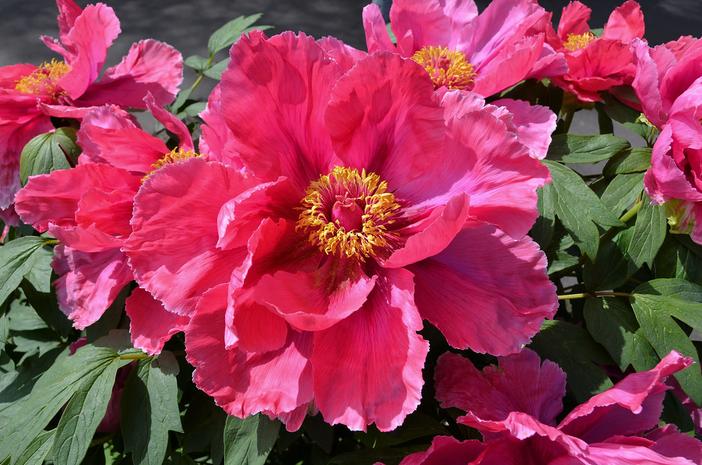Tree Peony
(Paeonia ×suffruticosa)
Tree Peony (Paeonia ×suffruticosa)
/
/

Patrick
CC BY-SA 2.0
Image By:
Patrick
Recorded By:
Copyright:
CC BY-SA 2.0
Copyright Notice:
Photo by: Patrick | License Type: CC BY-SA 2.0 | License URL: https://creativecommons.org/licenses/by-sa/2.0/ | Uploader: Morio60 | Publisher: Flickr
















































Estimated Native Range
Summary
Paeonia ×suffruticosa, commonly known as Tree Peony, is a deciduous shrub native to the rocky slopes and scrubland of Southeastern China. This group of cultivars, derived from hybridization within the subsection Vaginatae, has been cultivated in China for thousands of years, initially for traditional medicine, particularly the skin of its roots, and later for its ornamental beauty. Revered in Chinese culture, Tree Peonies differ from most peonies, which are herbaceous, by being woody shrubs. They can reach up to 4-7 feet in height and width, with large, showy flowers in a range of colors including white, pink, red, and yellow that bloom in early spring. The flowers are more durable than those of herbaceous peonies, and the woody stems allow the plant to survive winter, contributing to its longevity.
Tree Peony is valued for its spectacular blooms and as a specimen plant in gardens. It is also used in borders and as a focal point in landscape design. The plant prefers fertile, humus-rich soil with plenty of organic matter and requires medium amounts of water. It thrives in full sun to dappled shade, with dappled shade being preferable to protect the blooms and foliage from intense sunlight. While it requires little pruning, removing dead branches and suckers is necessary. Propagation is typically done by seed, which should be planted in autumn after air-drying. Tree Peony is hardy in USDA zones 3 to 8. Potential problems include peony wilt and botrytis, but these can be managed with proper care and site selection.CC BY-SA 4.0
Tree Peony is valued for its spectacular blooms and as a specimen plant in gardens. It is also used in borders and as a focal point in landscape design. The plant prefers fertile, humus-rich soil with plenty of organic matter and requires medium amounts of water. It thrives in full sun to dappled shade, with dappled shade being preferable to protect the blooms and foliage from intense sunlight. While it requires little pruning, removing dead branches and suckers is necessary. Propagation is typically done by seed, which should be planted in autumn after air-drying. Tree Peony is hardy in USDA zones 3 to 8. Potential problems include peony wilt and botrytis, but these can be managed with proper care and site selection.CC BY-SA 4.0
Plant Description
- Plant Type: Shrub
- Height: 3-5 feet
- Width: 3-4 feet
- Growth Rate: Slow
- Flower Color: Yellow, Pink, Purple, Red, White
- Flowering Season: Spring
- Leaf Retention: Deciduous
Growth Requirements
- Sun: Full Sun, Part Shade
- Water: Medium
- Drainage: Slow, Medium, Fast
Common Uses
Bee Garden, Bird Garden, Butterfly Garden, Deer Resistant, Drought Tolerant, Fragrant, Hummingbird Garden, Low Maintenance, Rabbit Resistant, Showy Flowers
Natural Habitat
Rocky slopes and scrubland of Southeastern China
Other Names
Common Names: Chinese Moutan Peony , Strauch-Pfingstrose , Pivoine En Arbre , Buskpion , 모란 , 목단 , Paeônia , Moran , Mu Dan
Scientific Names: Paeonia ×suffruticosa , Paeonia officinalis , Paeonia moutan , Paeonia decomposita subsp. rotundiloba , Paeonia decomposita subsp. decomposita , Paeonia decomposita , Paeonia szechuanica , Paeonia arborea , Paeonia ×arborea , Paeonia ×moutan var. albida-plena
GBIF Accepted Name: Paeonia ×suffruticosa Andrews